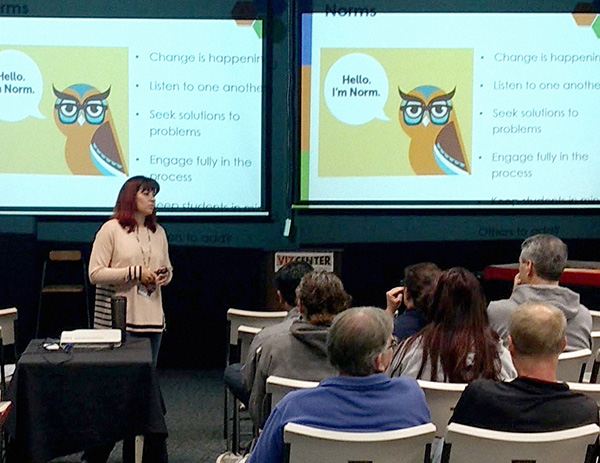By Jay Wilson Henry Cluster STEMM Foundation
The city of San Diego’s Water Department recently held their second annual Pure Water San Diego Open House at their North City Water Reclamation Plant and invited the Henry Cluster STEMM Foundation (HCSF) to attend.
Dr. Andrea Miyamoto, a HCSF member, took her fifth-grade daughter Kimberly, and classmate Lilia Espinosa from Dailard Elementary, and Lilia’s mother.

San Diego Unified School District science resource teacher Crystal Howe presented a one-hour program to the 14 teachers from Patrick Henry on new science teaching method
“Our visit started with a video about the Pure Water San Diego program. We enjoyed guided tours of the demonstration Pure Water Facility and North City Waterwise Garden,” Miyamoto shared. “Guests were offered samples of the purified water to taste in clear, biodegradable cups. This was a great opportunity to learn how the city protects our precious resource and plans to move forward with the next steps for providing a safe, reliable and sustainable water supply for San Diego.”
The foundation is going to be working with the Water Department to ensure the teachers within the Henry Cluster can avail themselves of the department’s educational materials for all grade levels as it relates to water production and conservation.
On Nov. 3, Patrick Henry science teachers attended the first workshop sponsored by HCSF to expand the partnership between SDSU and the schools in the cluster. It was held in the Visualization Lab at SDSU and hosted by Dr. Eric Frost, in cooperation with Dr. Stanley Maloy, the dean of the College of Sciences at SDSU. The objective was to bring together the science teachers from Patrick Henry and professors from SDSU who expressed a strong interest in working with our schools.
Dr. Frost summed up the event:
“The workshop opened with a presentation by Crystal Howe, the San Diego Unified School District’s science resource teacher about the new approaches to teaching science. SDSU professors from the College of Sciences and engineering gave PowerPoint presentations emphasizing the vision of teaching processes, not just content facts. I think everyone thought it was wonderfully successful, especially the very positive feedback of different SDSU speakers with each other about remote sensing, serious games, Earth processes, measuring things, student science research, and several other topics.
“Isabelle Sacramento Grilo gave a terrific and inspiring talk about natural disasters, showing how and why she uses graphics and animations to convey complex ideas of process, not just memorized words.
“Kevin Robinson followed up on these ideas in context of how content is built and how teaching is constructivist and multimodal and experiential.
“Steve Price from computer sciences (and Viz Center) talked about serious games and ways of teaching using games and on-campus clubs and peer teaching. He brought two students who did terrific jobs talking from the context of creating clubs on robotics and gaming — one was a Patrick Henry graduate who had several of the Henry teachers in the past.
“Tina O’Connor from Viz Center and Homeland Security Program talked about high-end use of remote sensing and visualization including in teaching things like high school biology, chemistry, physics, and math. She drew together concepts of lasers (LiDAR), spatial and spectral resolution, and host of applications including natural disasters and math.
“Alicia Kinoshita from civil, construction, and environmental engineering tied a host of pieces together with Alvarado Creek environmental studies, snow pack and field studies, fire and post-fire erosion and student research.”
Similar programs have now been offered to Lewis and Pershing middle schools. The foundation has also initiated a program where SDSU professors will visit elementary classrooms.
At the foundation’s November board meeting, Lisa Deaton, a Gage Elementary parent and a member of a motivated group of parent scientists committed to providing more stimulating science curriculum to their children, addressed the board.
“We are hoping to collaborate with parents from other schools in the cluster interested in working with us,” Deaton said.
Contact her at lmdeaton@gmail.com.
— Jay Wilson writes on behalf of the Henry Cluster STEMM Foundation. For more information, visit hcstemm.org.

